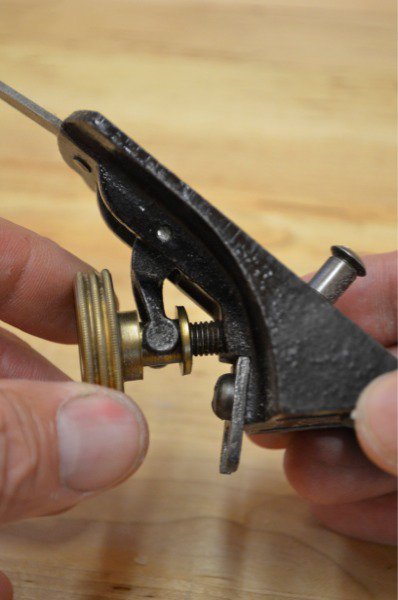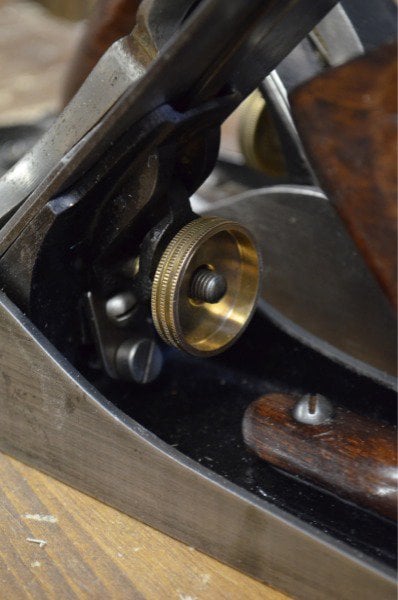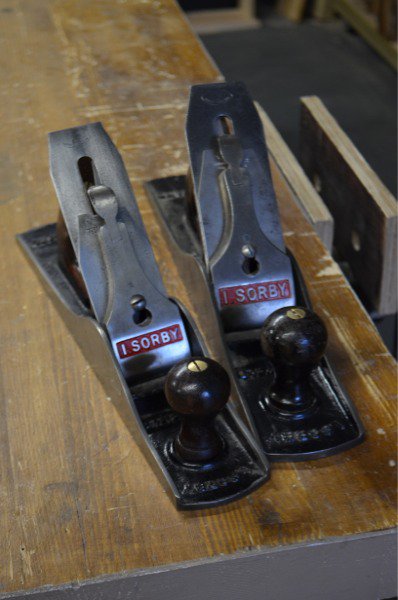Whiplash, Backlash – There is No Clash
Whiplash or backlash, these wheels have taken up the slack for over a century and they still work great.
I think whiplash is of little if any consequence to woodworkers in working their planes. It never made any difference to me and in reality the Stanley and Records that so dominated for a span of 150 years will likely never change. There are enough of them made to remain in the cycle of life now to out-supply even the demand of the new-genre woodworker worldwide. In one sense the Bailey-pattern bench plane in its various widths and lengths has become a legacy if you will and for the main part nothing has surpassed what has become one of the single most reliable resources available to woodworkers. The price of these planes has steadily risen since about two years ago and in general you can buy them for £20-30 or pay a little higher if it’s in good condition and has a yellow box via secondhand markets. I am thankful eBay has given us a place of tool exchange regardless of its possible pitfalls. Tools we would never have found are now providing a good source for us to collect and use tools that would have continued rusting in dark damp cellars and dusty dirty buckets and boxes. Whereas it’s true that I like the basic plane for several reasons, it’s also true that there are good higher end makers that go to great lengths to make a superior quality tool too. Of course there will never be a true comparison between the old and new as far as longevity goes because nothing and no one challenged Stanley and Record with any serious alternative until just a couple of decades ago. Even so, no new maker actually replicates the Bailey pattern and so the two plane types of Bailey and Bed Rock are indeed made differently to different patterns.
It’s not apples for apples at all really.


There can be no doubt as progress closed down the traditions of hand work over the past 50-90 years or so, so too we’ve seen a general declining in woodworking workmanship calling for skill and real insider knowledge once passed down from one craftsman to another emerging one. Just as the Stanley (of old, not today) supplies an endless supply of old planes, so too the internet is now bridging the gap in providing a working knowledge that no that no longer relies on the traditions of the past. Though I might lament the loss of what came to me as I was guided by a craftsman who watched me and helped me in my struggle, I am glad that I can pass on what I know to thousands of woodworkers around the world.


I always thought lash or whiplash was a sign of quality allowing one to sneak up on an adjustment for much finer control.
Paul, in terms of imparting your knowledge, the Internet is much more powerful.
1. You can share both written and video content.
2. You can share your knowledge with a significantly larger audience.
3. You can share your knowledge much longer. Previously, when a craftsman retired or died, their knowledge died with them. By documenting your expertise, it will live on and be use by generations hence.
Yes, I would love to learn from a true craftsman in my area. But like you say, the woodworking art is waning and it’s not that easy to find mentors. So the Internet provides others.
Regards,
Brad
I have no problem with backlash as I learned early on how to make adjustments for that. The only thing I still stuggle with is, after sharpening the iron, is getting it to take an even cut across it’s width. It always takes me quite a while – frustrating.
Thank you for all the knowledge you impart to us, it is really helpful.
Makes me all the more grateful to my Grandad for leaving me his tools, including a fairly old Stanly #4. This will be restored and hopefully used on my final piece for my carpentry course.
I have a modern premium #4 bedrock style plane and a 100+ year old Stanley #6 Bailey style. The modern plane is indeed very nice but the thick iron doesn’t work any better or last any longer than the thin original iron from my #6. I never really think about the backlash / whiplash.
If I knew then what I know now, I would have bought a vintage #4 and use the savings on wood or something else useful.
Very good article Paul. Today while checking Facebook to see if Paul had posted anything new I found myself posting a comment to a posting about C.N.C routing. It asked if woodworkers thought that using a C.N.C. was actually woodworking. I found myself posting no it is not. Machine operators is what I called it. I said working wood is using a hand saw a plane and chisel or a spokeshave. Hand tools powered by Human power is working wood. I must laugh at how passionate I feel about this now. Thank You Paul for teaching me how to enjoy woodworking and to love the idea that what I make will be around for a long time to come. As for whiplash I believe that if Stanley Tool Co did not want whiplash to be in the adjustment they would of made a thicker flange on the adjusting nut. But they didn’t so it must be there for a reason. Thank You for doing what you do Paul.
I completely agree, for me there is more to these old planes than just wood and steel. They were made by craftsmen for craftsmen,at a time when people took great care in their work. I have many tools with the previous owners name stamped on them, they certainly must have thought something of it or they wouldn’t have put their name on it. I am happy to use and care for these tools until one day hopefully a long time from now someone else takes an interest in them too.
I must say, I have a range of planes from different years and makers
I cant really tell much difference in the new chinese made records that I use as “beaters” for installations (dont mind if they get pinched) than the old baileys with balloon handles
It seems as long as its sharp and you can set the depth right they all do the job
The skill is in the users hands, not the tool
“a bad workman blames his tools”